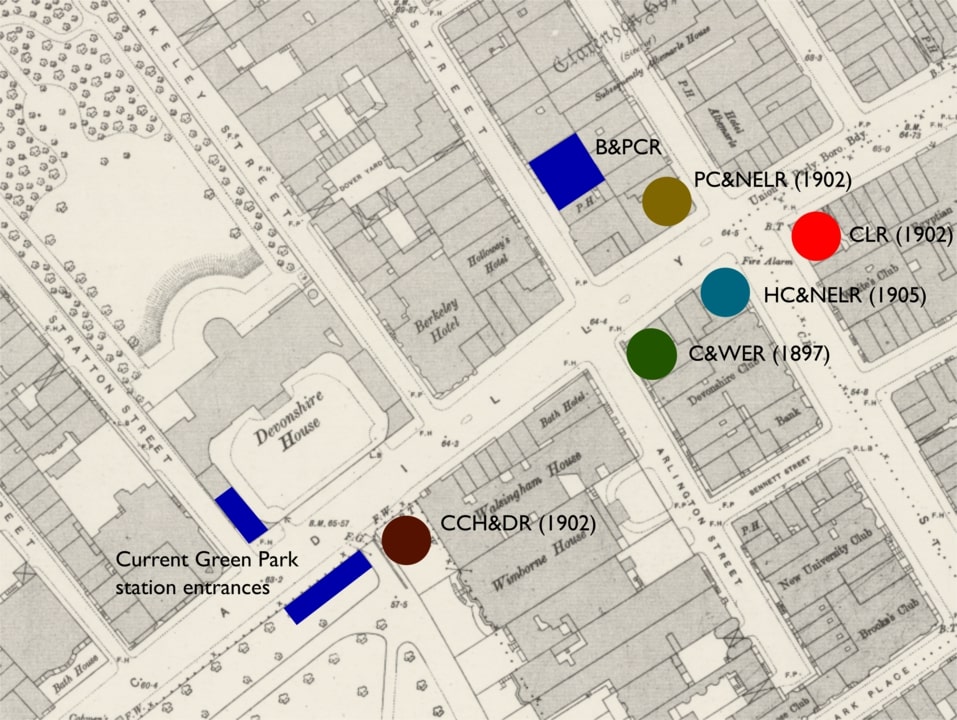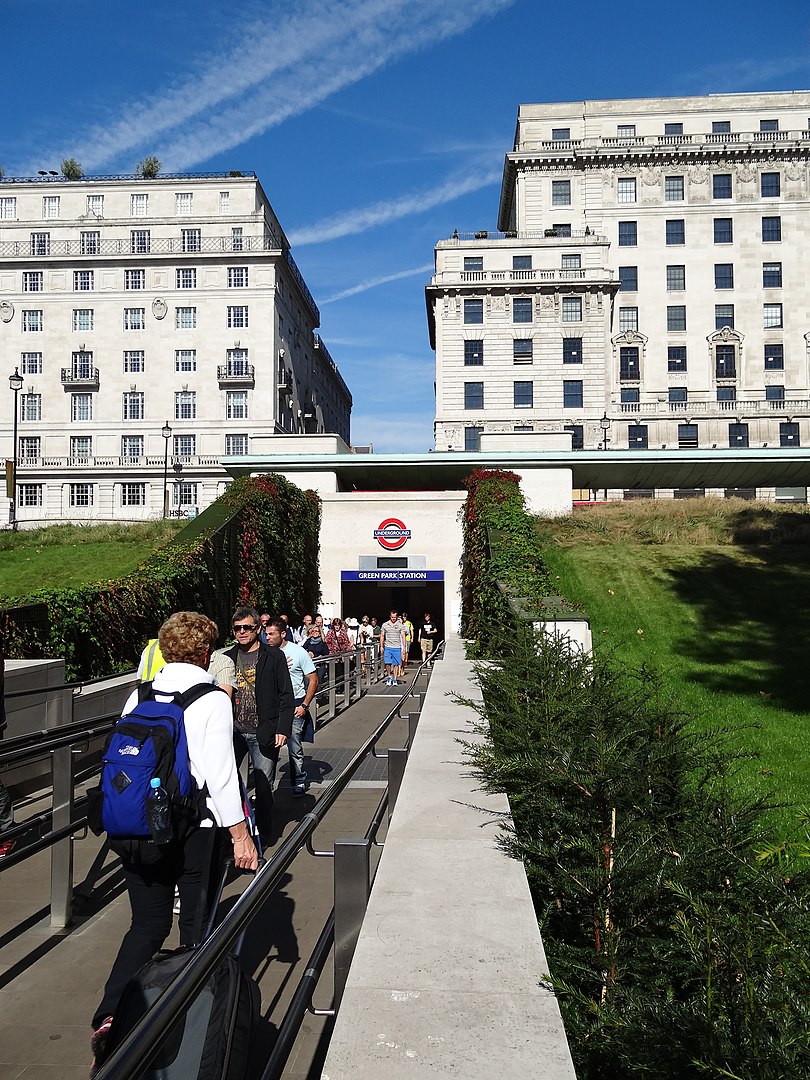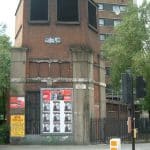Last Updated on 07/04/2023 by Alex Hamlyn
Table of Contents
Where is Dover Street Station?
Welcome to Dover Street Station
The London Underground is a labyrinthine network of tunnels, trains, and stations that have inspired fascination and frustration alike for over a century.
As a self-proclaimed Underground enthusiast, it’s my pleasure to share with you the story of one of my favourite stops: Dover Street Station, which later became Green Park Station.
All Aboard the Piccadilly Line
As London’s population and urban landscape expanded during the late 19th and early 20th centuries, the need for efficient public transportation became increasingly apparent. The development of the Underground aimed to address this issue by connecting different parts of the city and allowing people to travel quickly and easily.
Dover Street Station was built as a part of the Great Northern, Piccadilly, and Brompton Railway (GNP&BR), known today as the Piccadilly Line. The station’s construction was part of a broader effort to improve connectivity between various areas of London, including the West End, the city center, and the affluent neighborhoods of South Kensington and Chelsea.
Planning for the line began in the early 1900s. The GNP&BR was one of several new tube lines proposed to extend the existing underground network and improve transportation options for Londoners. In 1902, the GNP&BR received approval under the Great Northern, Piccadilly, and Brompton Railway Act, allowing construction to commence. This marked the beginning of the planning and development phase for the new line, including stations like Dover Street.
As the project moved forward, the railway company engaged architect Leslie Green to design the station buildings. Green’s distinctive style, characterized by the use of oxblood red-glazed terracotta façades, became a signature feature of Dover Street Station and many other stations on the Piccadilly Line.
Construction of the GNP&BR, including Dover Street Station, took place between 1903 and 1906. On September 15, 1906, the station officially opened to the public as part of the grand opening of the Piccadilly Line.
The location of Dover Street Station, in close proximity to the beautiful Green Park, was strategic. It provided convenient access to the park itself, as well as nearby attractions such as Buckingham Palace, the Ritz Hotel, and the high-end shopping district of Mayfair. By situating the station in this bustling and vibrant area, the Underground sought to cater to the needs of both local residents and visitors, promoting ease of travel and fostering economic growth in the process.
The Past Life of Dover Street Station
Our journey into history begins on September 15, 1906, when Dover Street Station first opened its doors to the public. Between 1906 and 1933, Dover Street Station served as a functional part of the Piccadilly Line, facilitating the transport of passengers to and from the surrounding areas. During this period, the station saw some changes and improvements, as the London Underground network continued to evolve.
In 1926, the Underground adopted Harry Beck’s revolutionary map design, which showcased a more user-friendly representation of the different lines and stations. This innovative design made it easier for passengers to navigate the network, including stops like Dover Street Station.
Another significant event during this period was the 1929 extension of the Piccadilly Line to the north, which brought additional connectivity to the network. While this extension didn’t directly affect Dover Street Station, it contributed to the overall growth and development of the London Underground.
In 1933, as part of a broader reorganization and renaming of several stations, Dover Street Station was renamed Green Park Station. This change reflected the station’s close proximity to the Royal Park of the same name, helping to create a stronger association with the surrounding area. The renaming also aimed to reduce confusion among passengers, as the new name was more closely linked to local landmarks. From this point forward, the station continued to operate under its new name, becoming the Green Park Station we know today.

Design changes
Originally the station entrance on Dover Street was above ground, just like many other stations on the Underground network. The platforms were at different depths depending on the line they serviced and the tunneling methods used.
The Piccadilly Line platforms are approximately 30 meters (about 98 feet) below ground level, while the Victoria Line platforms are around 27 meters (about 89 feet) deep.
These depths are typical for deep-level tube stations, which were constructed using the “cut-and-cover” method for shallower lines and the “Greathead Shield” tunneling technique for deeper lines. The depth of Green Park Station’s platforms ensures that they remain well below the surface, providing passengers with a comfortable and efficient travel experience.
Today, following the closure of the Dover Street entrance, The station is notable for having no surface buildings at all – it’s completely subterranean. Ticket halls, platforms, and even ventilation shafts are hidden beneath the ground, showcasing an impressive feat of engineering.
Tales from the Tube: Ghosts and Hauntings
While there are numerous ghost stories and haunted tales associated with various London Underground stations, Green Park Station isn’t as well-known for supernatural occurrences as some other stations.
Of course, Green Park isn’t the only station with a supernatural reputation – Aldwych Station and the disused British Museum Station also boast their own ghostly tales.
What makes this odd, though, is that Green Park itself was thought to be a medieval leper burial ground owing to its location neaby the St James’s hospital.
Conclusion
To sum it up, the old Dover Street Station is an amazing part of London’s travel history. With its special building style, underground structure, and long-lasting impact, the station shows off the city’s creative ideas and dedication to offering good public transportation.
As an important part of the London Underground network, this station has seen how the city and its transport system have changed over more than 100 years.
Even though it’s not famous for scary ghost stories like some other stations, Green Park Station’s interesting past and ongoing role in linking people in London and those visiting make it an exciting and important stop on any trip through the city.
Image credits
- Dover Street Station Entrance: By Ian Wright – 23 – Green Park Entrance, CC BY-SA 2.0, https://commons.wikimedia.org/w/index.php?curid=70940665
- Dover Street Station Original Entrance: By David Cane – Background map: Ordnance Survey map: London VII.72 revised 1894, published 1895, original scale 1:1056.Station locations as described in Badsey-Ellis, Antony (2005) London's Lost Tube Schemes, Capital Transport ISBN: 185414-293-3., Public Domain, https://commons.wikimedia.org/w/index.php?curid=70842727
References
- https://en.wikipedia.org/wiki/Green_Park_tube_station
- https://www.mylondon.news/news/zone-1-news/green-park-london-underground-tube-17504181
- https://www.mylondon.news/news/nostalgia/abandoned-london-underground-station-became-21349696
- https://www.amazon.co.uk/Londons-Disused-Underground-Stations-Connor/dp/185414250X
- https://en.wikipedia.org/wiki/Green_Park
- https://www.spectator.co.uk/article/underground-ghost-stations/
- https://www.higgypop.com/hauntings/green-park/



